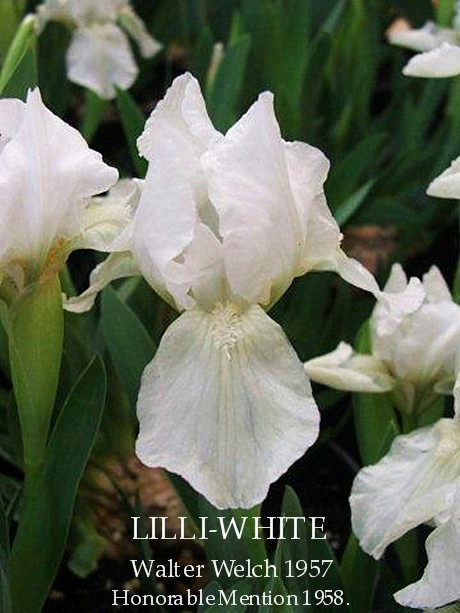DWARF IRIS PROMOTION
Walter Welch
In the past our hybridizers like Caparne, Burchfeild, and the Sass Brothers worked with the chamaeiris species almost entirely because this species was available and gave the best performance though it was lacking in color and pattern range. The Sass Brothers used only Socrates and its seedlings for all of their varieties, and chamaeiris gave only purples, yellows and a few rare whites.
I. pumila and other dwarf species had never been in this country before our time. Apparently the first pumilas were seed sent to Bob Schreiner, who grew them and selected Sulina, Carpathia and Nana; though these were not registered with the AIS. Later our Robin members on Europe such as Hansel-Mayer, Eckers Berlin, Hugues de Balzer went into the wild and collected and sent species to me and I distributed them to our breeders.
The species I.pumila apparently has the widest color range of any iris. But I.pumila won't grow well in some areas, like in California, and down south in Georgia, Arizona and Texas. In pumila we have the true blue, purple violet, white, yellow and such patterns as the spot pattern with gives us amoenas,variegatas, Pinnacles, neglectas, and from these colors and patterns the variations are unlimited.
So if we can get all of these colors and patterns up into the chamaeiris forms, with that performance which is inherent in this species, we will have a dwarf that is everything.
I have a plan which will achieve this, which will not only give us the the dwarf of the future, but keep our breeders busy for half a century like the AIS has done with the Talls, and this will put our dwarfs on the map and keep it there. So here is my plan.
This new dwarf will be called Chammy Dwarf. In other words it will become like the present chamaeiris varieties but with all of the colors and patterns known in the pumilas. So how do we achieve this miracle???
First we cross the particular pumila onto a tall bearded iris, to get a Lilliput, with the form desired among it's seedlings. No Doubt this will to big and coarse, with the usual faults known in the Lilliputs. But the important thing is color or pattern. Next we cross this Lilliput with a Chamaeiris "tool" which we have developed and tested for giving a desirable form from this coarse Lilliput, smaller and more dainty.
This tool will take some time to develop, but it can be done. No doubt it must be a white form, which will be neutral in color yet pass along the color of the Lilliput. I am working on this and making some progress. We will need a spot tool also, as spot requires a full dosage of spot factor to give good expression, An anoema tool will be the best. At present we have a tool in yellow, which I call Little Yellow but will test this further.
And as usual with development of a specific color or pattern if or when this cross does not give full satisfaction, we can sib cross the two best seedlings to improve it. This is not a case of quick results. It can take perhaps three generations in some cases, which is six years ordinarily, but remember we are creating relatively a new species, and it is worth the trouble.
No doubt some of us will find a more easy way to achieve certain things. For instance by selection of a certain tall as a mother plant for a more desirable Lilliput. Or perhaps a reverse cross like tall upon pumila may be desirable. Anyway the selection of a tall parent can make a big difference on size of plant, branching, and especially form of bloom. All of this must be worked out as there are no rules to follow. This is a new approach.
Several things can be calculated. For instance, pumila has an inhibitor that will erase all anthocyanin pigments from the progeny, leaving the yellow if present, in the seedlings. But if yellow is avoided, only the pumila colors will be present.It erases only the anthocyanin, not anything else.
Just imagine if we can get a true blue in a chamaeiris form, a black, brown, violet, red, purple, amoena, Pinnacle, maybe yellow standards and blue falls. All of this is possible in our Chammy Dwarfs. And when we get all of this in a plant that will perform well in vast areas, our dwarfs will continue as with the Talls today.
At present we have two Chammy Dwarfs, by chance. These are 'Fashion Lady' and Lilli-White. Both are still in bloom here, full of bloom, not damaged by the freezing apparently, and the only one in bloom in my border where it is planted with all my varieties. This has been a lesson for me.
The above article was composed by Walter Welch in 1976 for the Minnesota Iris Society.
AIS Checklist 1959
LILLI-WHITE (Welch, R. 1957). Sdlg. L-56i. SDB 12" L. W1. Pure white self, white beard. (Blue Shimmer x Carpathia) x J-538: (Bouquet x (Fiancee x Fairy))., Welch 1958. HM 1958.
Heritage Irises would like to wholeheartedly thank Sue Marshall of Iris of Sissinghurst for kindly permitting the use of the above image of Lilli-White. Sue writes this morning that due to a late spring Lilli-White has just come into bloom.
Reproduction in whole or in part of this post, its opinions or its images without the expressed written permission of Terry Johnson is strictly prohibited. Photo credit and copyright of Lilli-White is Sue Marshall and Iris of Sissinghurst ©.




















0 comments:
Post a Comment